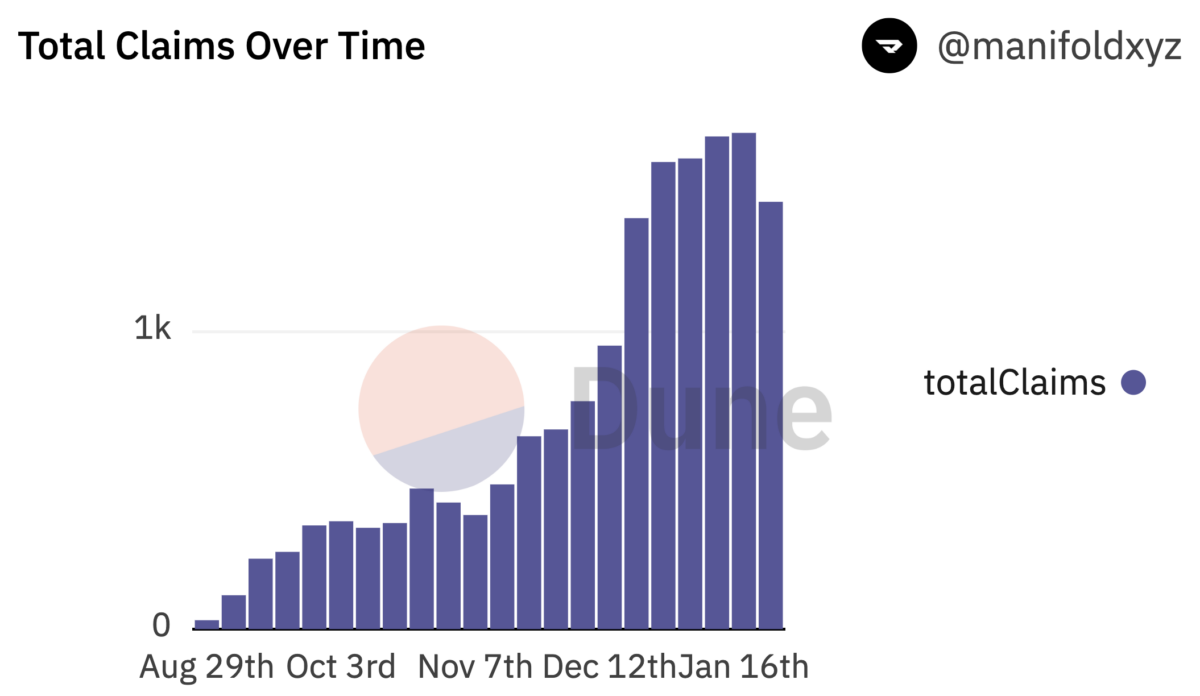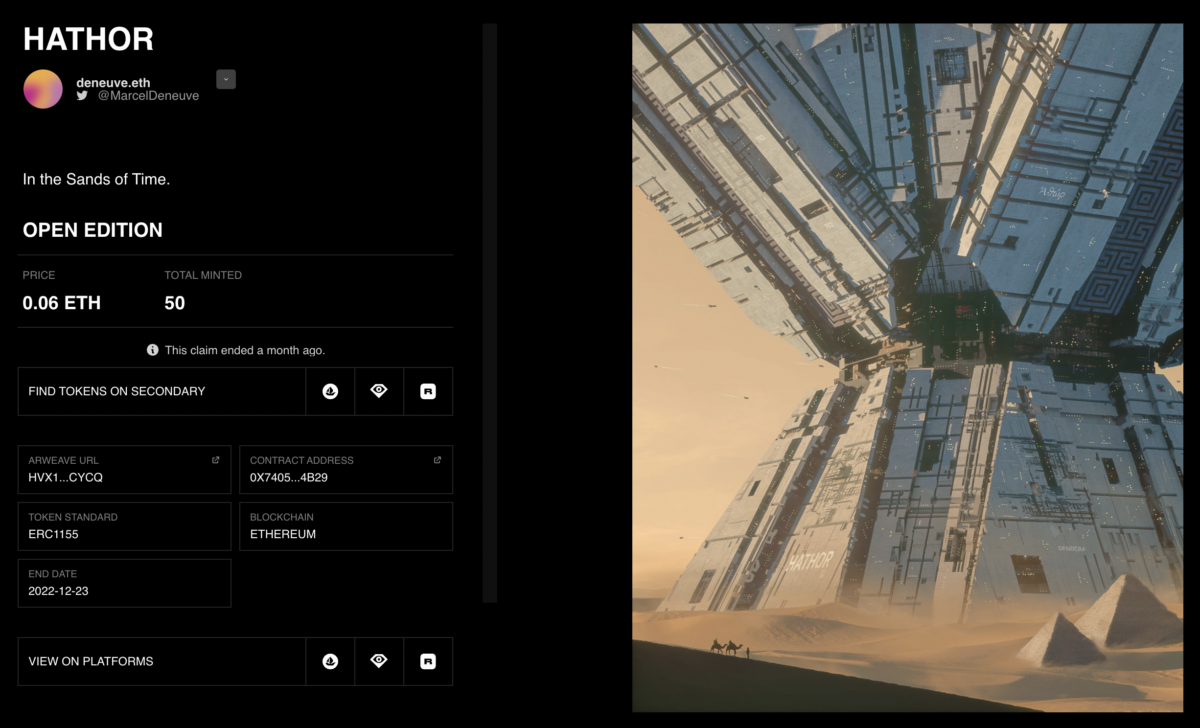For Better or Worse, NFT Open Editions Are on the Rise
The rise of the open edition (OE) is officially here. After increasing in popularity throughout 2022, the last few months have seen thousands of artists and Web3 builders creating claim pages for open-edition mints. The NFT community has flocked to them in droves, generating millions in revenue and reinvigorating the crypto art space as it tries to shake off the icicles of a frosty 2022. Beyond the financial boost, OEs benefit the NFT ecosystem by driving engagement, allowing an artist’s fan base more opportunities to collect their work while expanding that community’s reach at the same time.
This all sounds like good news — and it is, depending on who you ask. While some celebrate open editions, others worry that they ultimately harm the space, diluting the value of an artist’s output (most notably their 1-of-1s) and bringing little to collectors in terms of utility. There’s also the question of the unknown long-term effects that OEs have on a body of work.
To parse out these concerns and understand why open editions have begun their staggering ascent, we looked at the numbers and spoke to some of the artists and collectors who know the OE trend best. But first, it’s worth understanding the historical context behind this upswing.
How did open editions get so popular?
Open editions are NFT drops with no set supply limit, allowing collectors to mint as many tokens as they want within a certain period (usually within 24, 48, or 72 hours). They can also be open-ended, with no time limit, though these are somewhat rarer. The open edition itself isn’t a particularly new drop methodology in the NFT space (Beeple famously dropped three open editions on Nifty Gateway in 2020, for example), but the sheer volume of OEs showing up on the radar recently is unprecedented. Countless artists have joined the OE rush in recent weeks and months, including Terrell Jones, Lucréce, and Marcel Deneuve. And their mints are mostly being met with enthusiasm from their communities and fans.
This surge in popularity can be attributed in part to two things: the dissemination of democratic minting infrastructure from the likes of platforms like Manifold and Zora throughout 2022 and well-known artists experimenting with open editions over that same year. Such experimenters include Grant Riven Yun and Isaac ‘Drift’ Wright, the NFT photographer who dropped First Day Out in April 2022 as a 24-hour open edition to commemorate his release from prison a year earlier.
That drop sparked an ongoing conversation about utility in the NFT space and whether or not artist pieces — whether OE, 1-of-1, or limited editions — need to come with some additional value or application for collectors beyond just being a piece of artistic work. It also caused people to reconsider how such drops would affect the pricing and value of a well-known artist’s unique 1-of-1 pieces.
Behind the rise: Manifold’s Claim Pages and Zora’s Editions
Drift released his open edition on Manifold, a minting platform that might be the most meaningful contributor to the proliferation of the open edition in recent months. First Day Out was minted on Drift’s customized Manifold smart contract. The release likely helped influence the platform’s decision to develop a way for NFT community members with no coding knowledge to easily do the same. Manifold’s goal has always been to give Web3 community members access to tools they can use to create customized drop experiences for their communities. While larger platforms like OpenSea had launched similar “storefront” capabilities in years prior, they were substantially limited in what artists could do with their drops.
Manifold’s most significant impact on the OE movement came when it launched Paid Claim Pages in October 2022. An extension of its Claim Pages functionality which let artists set up pages for free mint drops, Paid Claim Pages allowed users to launch a drop page for limited and open editions for ERC-721 and ERC-1155 tokens, just like Drift had done earlier that year. The result? Currently, over 16,000 claims have been created by over 6,000 users on the platform, churning out nearly 15,000 ETH ($20 million) in total primary sales volume, according to Dune’s analytics dashboard.

Zora is another NFT marketplace protocol that, along with Manifold, has played a significant role in the OE craze. For those unfamiliar with the name, Zora was the platform through which artist and designer Jack Butcher chose to launch his now well-known NFT project Checks VV. Since launching its Creator Toolkit in May 2022 and giving users a no-code-required way to mint and drop NFT collections, nearly 240,000 unique wallet addresses have minted an edition of some kind, either fixed-sized or open edition.
And while the majority of the more than 8,500 contracts deployed on the platform have been for fixed-size edition drops, that ratio is rapidly beginning to swing in the other direction. Out of the 1,525 total ETH primary sales volume that Zora’s Creator Toolkit has generated since its release (along with over 16,000 ETH in secondary sales), over half can be attributed to OE drops, according to Zora’s Dune analytics dashboard. Combine that with a distinct statistical shift in the kind of collection users are creating on the platform starting in January of this year, and it’s clear that the open edition has hit an inflection point.

What artists and collectors are saying
Not everyone is entirely on board with open-edition fever, however.
“It’s a free market for artists, buyers, and collectors to do as they wish,” said influential NFT collector, influencer, and Web3 builder 33NFT of open edition popularization in an interview with nft now. “But an artist can sell too many editions — thousands or more — which, in my opinion, can end up causing a headache, as the artist and buyer usually want to see the post-mint price rise or at least keep stable above the initial mint price. It appears as an afterthought when, a few months later, an artist announces there will be a burn event, or that very large editions can be used as purchase tokens to submit in exchange for a 1-of-1 artwork.”
“I wouldn’t recommend any artist to drop an open edition until their 1-of-1s have become unaffordable for most.”
33NFT
The collector referenced Beeple’s 2020 open edition drop with Nifty Gateway as an example of an OE done right. During that drop, Bull Run, Infected, and Into The Ether sold for $969 each. In 33’s eyes, the relatively high price and resulting low volume from the OE drop struck a good balance between accessibility and value preservation rather than coming across as something like an artist’s initial coin offering (ICO).
“Generally, I wouldn’t recommend any artist to drop an open edition until their 1-of-1s have become unaffordable for most,” 33 continued. “There should also be a good reason for the open edition. I’d much rather see a limited edition of 50, 100, or 1,000 if the artist so wishes. But I like to know what that number is.”
In contrast, some artists in the space take umbrage with the idea of scarcity. Visual artist and sci-fi futurist Marcel Deneuve believes that open editions can be a great way to keep the NFT community healthily balanced, ensuring that it’s not just community members with deep pockets and expensive 1-of-1s dominating the space.
“1-of-1s are for a very specific group of people; only a few can actually afford them,” Deneuve said while speaking to nft now. “But there are lots of fans who want to get collectibles and support their favorite artists. This was the main reason I started making OEs.”

Deneuve has minted several NFTs on Manifold in recent weeks, and, in his view, the community response has been a success. Like other collectors and artists in the space he talks to, Deneuve isn’t committed to any one type of drop but thinks exploring options that his collectors request is worth doing.
“I think the concept of scarcity is a bit overrated.”
Marcel Deneuve
“As long as folks ask me to make it, it is a success,” Deneuve underlined. “I will continue doing both types of drops, but my focus is definitely on OEs. Even though too much supply is bad for artists, I think the concept of scarcity is a bit overrated.”
The future of the open edition
Some artists are wary of the unforeseen effects open editions might have. Prominent NFT artist and photographer Cath Simard recently took to Twitter to express both her interest in and hesitation with the open edition, striking an ambivalent tone that likely resonates with plenty of other artists in the space. Similarly, minimalist artist and NFT figurehead Grant Riven Yun has said that he believes a higher number or low-priced 1-of-1s is superior to a large number of an edition of a single piece for both artists and collectors.
33NFT advocates that the community looks at open editions on a case-by-case basis. The evolution of the NFT space is unlikely to resemble how it grew in the past, and what works for one artist may not work for another.
“It all depends on where an artist is in their career,” 33 elaborated. “I think most people would rather own a 1-of-1. Back in the day, XCOPY was selling 1-of-1 artworks on SuperRare for around $100, and he fully deserves to be where he is today. But now, newer NFT artists rarely want to sell 1-of-1s for that much and want more notable dollars quicker. If they don’t yet have that demand, maybe they think they can pay their bills with an OE.”
As open editions continue to grow as a dynamic in the ever-evolving NFT ecosystem, artists should keep a cautious eye out for the long-term effects they might have but not be terrified of utilizing them. That the space is experimenting with OEs is healthy in and of itself. As a collector, it’s best not to mint an open edition with an eye toward it becoming an extremely valuable asset either immediately or sometime down the line.
The concept of supply as it relates to value in art is nothing new, as many have pointed out. NFTs enable artists to interact with their collectors in previously impossible ways, so it was inevitable that this age-old debate in the traditional art world translated to Web3. How artists choose to navigate it is up to them, but both lauding open editions as a silver-bullet solution to bear market conditions and lambasting them as a harmful and diluting force for collectors are short-sighted lenses through which to view change in an industry that is built on innovation.
The post For Better or Worse, NFT Open Editions Are on the Rise appeared first on nft now.


